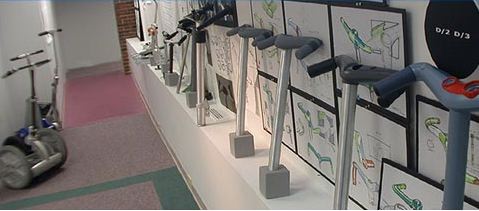

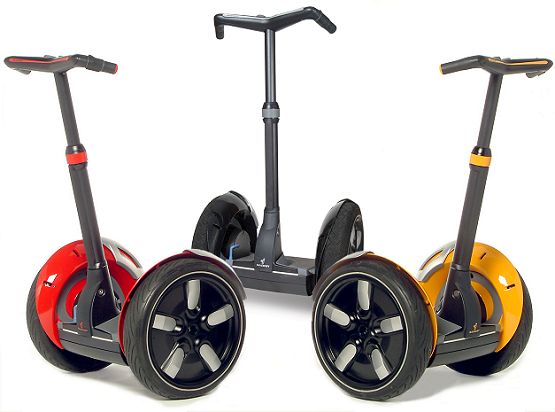
Segway HT i180 (i Series) Red, Yellow and Midnight Blue-colors with NiMH or "Saphion" Lithium batteries (OS
14.1)
Released 3/05; Original Price $4495 NiMH, $4995 Lithium (Current Price $4995 Lithium)
-Style: Just as the change from the i167 to the i170 was an upgrade in style, the i180s were more of the same. The popularity of customized motorcycles and, in particular, television programs like "American Chopper" and "Biker Build-Off" on the Discovery Channel may have impacted the design and style of the HTs of 2005. Stunning "Sport Red," "Solar Yellow" and "Midnight Blue" (black) glossy colors, re-designed fenders, and new black wheels with inserts designed for customization were an excellent upgrade to the style of the human transporter. This was also a bit of a departure in philosophy where the origin of the HT was to change the world, the i180 recognized appealing to customers as a "fun" product may also help the public accept the HT and keep the company in business. The nationwide dealerships for HTs are often locations that also sell other vehicles, like ATVs, motorcycles etc, and the red and yellow i180s fit right in and their prices feel inexpensive next to $25,000 for a Harley. As was the case for the i170, the meaning behind the new model number "180" had nothing to do with a 10% gain in battery life especially given Lithium batteries increased range by likely greater than 100%, but rather reflected the concept of an increment of "progress" with a new model.
-Battery Type: The company, Valence Technology Inc., was one of the first to develop a successful method using phosphate buffers to create Lithium batteries that deliver lots of power but don't over-heat or catch fire. The new Lithium-ion (Li-ion) Battery Packs essentially doubled the range of the HT, as well as lessened temperature-dependence and memory issues that made the Nickel Metal Hydride (NiMH) batteries a bit high-maintenance. The i180 was the first Segway HT that came with optional "Saphion" lithium-ion battery packs. These first generation battery packs from Valence for the Segway HT were a bit thicker than the previous NiMH packs, yet they weighed essentially the same. They were completely compatible with all previously released i Series models but the HT did need a software update to version 14.1. In 2005 this battery upgrade had a large impact on interest in Segway HTs in corporate circles. Many early trials in 2003-2004 with commercial clients (like US Postal Service) were hindered primarily by less-than-adequate battery life of the NiMH packs (8-12 miles). In 2006 if enough commercial customers are convinced to revisit this issue with the i180 HT and Li-ion packs (15-24 miles), it could change Segway Inc's situation considerably.
The Segway LLC product description at release March 1, 2005:
The Segway Human Transporter (HT) i180 is our most versatile and colorful model. With new fenders, wheels and battery options, it was designed for extended range, stability and plenty of cargo capacity. The i180 readily navigates a wide range of operating environments and terrain. The i180 is one of the first Segway HTs available with optional Saphion lithium-ion batteries. The new batteries deliver an impressive range of up to 24 miles on a single charge, depending on terrain, riding style and payload. Saphion lithium-ion batteries are low-maintenance, have a long service life and can operate at battery temperatures as low as 14 F (-10 C). Nickel metal hydride (NiMH) are also available. The i180 also features newly designed fenders and wheels, as well as coordinating accents of color on the control shaft and handlebars. Moveable silver splashguards on the fenders allow the rider to customize the look of the Segway HT. Position them toward the front of the fenders for a more aggressive look; move them to the rear for maximum spray protection; or, remove them completely for a sleek, minimalist look. The i180 is the first Segway HT to roll on new black wheels that come standard with contrasting silver inserts. Five inserts are designed to fit into slots within the wheel; with one slot marked with a subtle notch to identify the location of the air valve hidden beneath. For further customization, additional splashguards and wheel inserts will be available from Authorized Segway Dealerships or online at the Segway Shop. Splashguards and wheel inserts are currently available in Sport Red, Solar Yellow, and silver. In addition to the redundant safety features at the heart of all Segway HT models, the i180 comes equipped with a number of standard features. Power assist mode allows you to move the device up and down stairs more easily. The control shaft is adjustable to the comfort of the rider and allows the Segway HT to fit in the trunk of many cars. To help prevent theft, each Segway HT comes with its own set of keys, encoded with a unique 64-bit security identification. The i180 also comes with a mechanical parking stand.
-Top
speed: 12.5 miles per hour (20 km/h). This is about three times typical walking speed.
-Weight: 83 lbs (36 kg)
-Width: The Segway's footprint (how
much space it covers on the ground) is 19 by 25 inches (48 by 63.5 cm). This makes the Segway about the same width as an average size person, so it doesn't take up much
space on the street. The platform is 8 inches (20 cm) off the ground. With Lithium batteries ground clearance is only 3 inches 7.6 cm [with NiMH it's 4 inches (10 cm)].
-Weight capacity: Total limited to 260 pounds. Some combination of up 250 pound (110 kg) person with up to 75 pounds (34 kg) of cargo.
-Range: 15-24 miles
(24-39 km) [Li-ion] / 8-12 miles (13-19 km) [NiMH]. Operating temperature with Lithium-ion batteries 14-122 degrees F (-10-50 C) and with NiHM batteries 32-122 degrees F
(0-50 C).
-Driver interface: The Segway has a small multicolor backlit LCD screen that tells the driver how much battery power is left and how well the vehicle
is functioning. The screen displays a cartoon face, which expresses the general condition of the vehicle. The driver interface is designed to be simple and intuitive.
-Motors: Each of the Segway's wheels is driven by a 2-horsepower electric motor that produce no emissions. Dynamic stabilization--five solid-state,
angular-rate-sensing gyroscopes and twin-tilt sensors monitor balance 100 times per second to help the HT compensate for the difference between the rider's body movements,
varying terrain, and the direction of gravity.
-Transmission: The two-stage transmission, built by Segway and Axicon Technologies, has a compact 24:1 gear ratio.
It uses a helical gear assembly that significantly reduces noise. The Segway team configured the two meshes in the gear box (the points where gears connect) to make sound
exactly two octaves apart. This means the sounds are in harmony, so the gear box make a more musical noise. The gears are also designed to have noninteger gear ratios,
meaning the gear teeth mesh at different points from revolution to revolution. This minimizes wear and tear to extend the life of the gear box.
-Computer: The
Segway's brain is made up of two circuit boards, housed in the vehicle's chassis. The circuit boards, which boast a total of 10 microprocessors, normally work together, but
each can function independently in the event of a computer problem. If one breaks, the other circuit board will slow the vehicle down gradually to avoid an accident.
-Power: The Segway is powered by two rechargeable batteries. Segways come with either new Valence Inc "Saphion" lithium-ion batteries or nickel metal hydride (NIMH)
batteries. The batteries are constantly monitored by a circuit board, which communicates any performance problems to the central brain. The batteries can be recharged with
household AC current. Dean Kamen estimates a Segway would cost somewhere around 5 cents a day in electricity bills.
-Sensors: The Segway uses five gyroscopes and
a collection of other tilt sensors to keep itself upright. Only three gyroscopes are needed -- the extra sensors are included as a safety precaution. The Segway has an
additional weight sensor built into its platform to tell the computer when a rider has stepped on.
-Brakes: The Segway doesn't have a braking system. To stop,
the rider stands upright without leaning forward or backward, and the vehicle maintains its position.
-Turning radius: Since it only has two wheels, the Segway
can rotate around a single axis (the wheels turn in opposite directions). This gives the Segway a turning radius of zero.
-Wheels: The Segway wheel consists of a
forged steel wheel hub with a glass-reinforced thermoplastic rim. Each wheel is secured to the drive shaft with a single nut. The tires are made of a silica compound, which
provides good traction even on wet surfaces.
-Security: The Segway uses an electronic key system. The key, which looks something like a car lighter, stores a
128-bit encrypted digital code. The vehicle won't start unless the key is plugged into its port. The key can also store settings for vehicle operation. Segways include one
black key for "beginner mode," where the vehicle has a lower maximum speed, and middle yellow key, and one red key for "experienced mode." Segway plans to offer
programmable keys down the road, which well let users store particular operation settings.
-Chassis: The Segway's sensitive electronic equipment is housed in a
sturdy die-cast aluminum chassis. According to Segway, the chassis can withstand 7 tons of force.
-Control shaft: The aluminum shaft that holds up the Segway's
handlebars can be adjusted to different heights. Riders can attach clips to the shaft to carry bags or other cargo.
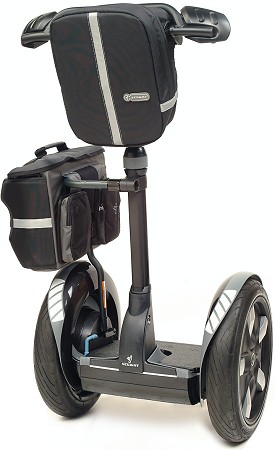
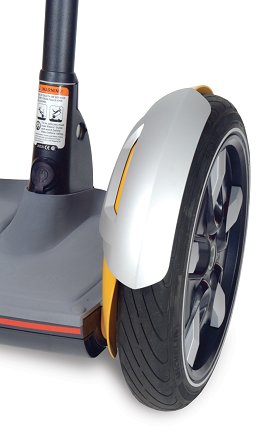
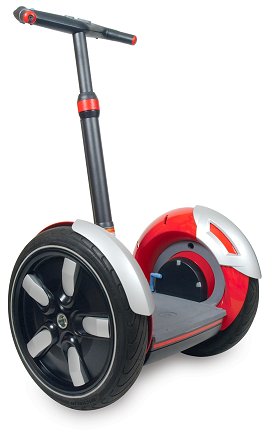
CHANGES: Elements of the original i180 model human transporter that were changed from the previous i170 model included: the availability of the Lithium batteries, the color schemes, the new black wheels with removable silver inserts, the trim on the handle bars, the half-size fender with adjustable/removable silver splash guards, and software updates to 14.1 which recognized both NiMH or Li-ion batteries.
